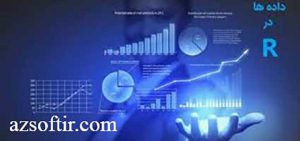The R tool provides a coding environment and an environment for statistical data analysis and data mining. Currently, many projects in the field of statistical calculations and data mining are carried out with R. Also, R is widely used in academic and research environments.
You can contact azsoft group for consulting and performing data mining projects with R and R statistical analysis.
Doing data mining projects and commercial data mining projects and academic and research projects with R R software – doing data mining projects R R – doing data mining projects R R – doing projects with R R – doing data mining projects R programming language – doing statistical projects with R – doing statistical projects with R
It is done by azsoft experts.
How will the project order be registered on the azsoftir site?
To register your order, you can register via email address azsoftir@gmail.com or contact number +989367292276
R programming language
There are many programming languages that are used in data mining and analysis and statistical calculations and information display projects, which are designed based on S and Scheme by the research team of Rice Aikaha and Gentleman. History of presentation of R language
The R programming language was designed and introduced by the research work of Ross Ihaka and Robert Gentleman. Currently, the R program is available on its website and is open source.

R software
R programming language features
R language has many tools for using graphical facilities and statistical methods. In the R coding environment, you can directly call the codes of C and C Plus Plus and Visual Basic and Furnace. Although this programming language is mostly used for statistical work, it also has the ability to perform matrix calculations. Classic statistical tests, Linear and non-linear modeling, classification, clustering, etc.
Features of the R language
The R programming language has a wide range of graphical capabilities and statistical techniques. In the R software environment, analysts can call and use C++ and C codes as well as Fortran. The statistical techniques used in R programming are, for example, classical statistical tests, linear and non-linear modeling, classification, clustering, etc.
It has a powerful and multi-purpose library for analytical operations in various scientific topics.
It has good packages in the field of analysis and statistical calculations.
Strong libraries in the field of machine learning and data mining such as classification and regression and social media analysis.
Doing R statistics projects
Carrying out R statistics projects can include various topics, some of which I will mention below:
1- Doing R statistics projects, economic data analysis: Using R, you can analyze economic data, look for new patterns and useful information for your business. Some of the economic projects that can be done with R are: forecasting economic growth, analyzing consumer behavior, and the effects of government policies on the economy.
2- Carrying out statistics projects R analysis of behavioral data: R is one of the best tools used to analyze behavioral data. Using R, you can create psychographics and understand consumer behavior to improve sales and further marketing strategies.
3- Doing statistical projects R research projects: R is a powerful tool for research data analysis. In research projects, in addition to data analysis, you can use R to create 3D diagrams and show the results visually.
4- Carrying out R statistics projects for medical data analysis: R is also very useful for medicine. You can use R to analyze the results of medical tests and display the results graphically.
5- Doing statistical projects R business projects: using R you can analyze your business data and look for ways to improve business performance. Using R, you can implement new algorithms and look for ways to improve performance.
6- Carrying out R statistics projects, analyzing social data: Using R, you can analyze social data and look for new patterns and solutions to social problems.
Overall, R is a powerful tool for data analysis. Doing R statistics projects using R can be done in various industries including: scientific research, business, medicine, social and economic. Using R, you can display data analysis results graphically and visually and look for optimal solutions to your problems. Of course, in this regard, it should be noted that to do R statistics projects, you need knowledge and experience in the field of statistics and R programming.
Some of the completed R statistics projects include:
7- Carrying out R statistics projects, analysis of accounting data: using R, you can analyze accounting data and look for new patterns and optimal solutions for accounting problems. Some of the accounting projects that can be done with R are: profitability forecasting, accounting cycle analysis, and company activity analysis.
8- Doing statistics projects R marketing projects: using R you can analyze marketing data and look for optimal solutions to improve your marketing strategies. Using R, you can implement new algorithms and look for ways to improve performance.
9- Doing R statistics projects, environmental data analysis: Using R, you can analyze environmental data and look for new patterns to improve the environment. On
10- Carrying out R statistics projects, analyzing financial data: Using R, you can analyze financial data and look for optimal solutions for financial problems. Some of the financial projects that can be done with R include financial risk analysis, stock price forecasting, and mutual fund performance analysis.
11- Carrying out R statistics projects, analyzing data related to networks: using R, you can analyze data related to networks and look for new patterns to improve network performance. Some of the network related projects that can be done with R are: network data transfer analysis, network stability analysis, and cyber attack data analysis.
Overall, R is one of the best data mining and data analysis tools, and statistics projects using R can be done in various industries. Of course, to do R statistics projects, you need knowledge and experience in the field of statistics and R programming. Also, you can use various R libraries like ggplot2 for drawing charts and graphs, dplyr for data analysis and various other methods using R.
Finally, to do R statistics projects, you need to be familiar with data and be able to analyze it well. Also, you should know R programming well and be able to use various R libraries and tools. Finally, you should have a good understanding of the results of data analysis and use them to find optimal solutions for your problems.

Stages of R data mining projects
Well, to start a data mining project using the R language, you can follow these steps:
Data collection: The first step in any data mining project is to collect the required data. You can use sites like Kaggle and UCI Machine Learning Repository to access public datasets. You can also collect your own data.
Loading the data: After collecting the data, you need to load it into R. You can use functions in various pckages like readr and readxl to load data.
Data Preprocessing: You need to preprocess your data. This process includes removing incomplete data, normalizing data and extracting required features. To do this, you can use the functions available in different packages such as dplyr and tidyr.
Modeling: After pre-processing your data, you can train different models to answer your questions. You can use the functions available in different packages such as caret and mlr.
Model evaluation: After training different models, you need to evaluate them. This process involves evaluating the performance of the model using various criteria. You can use the functions available in different packages such as caret and mlr.
Review and interpret the results: After evaluating the models, you should review and interpret the results. At this stage, you can use the functions available in different packages such as ggplot2 and dplyr.
Reporting: After reviewing and interpreting the results, you should prepare a report of your project. In this report, explanations about the data, the methods used, as well as the results and their interpretation should be discussed.
I hope these steps were helpful for you. Also, it is better to save your codes at each stage of the project along with the explanations and important points that you have obtained during the project so that you can access them when needed.
You can also use various educational resources such as books, videos, and online tutorials to learn more about data mining using R. Things like the book Applied Predictive Modeling by Max Kuhn and Kjell Johnson and the book Machine Learning with R by Brett Lantz are among the useful books to start with.
However, to carry out a data mining project successfully, you need knowledge and experience in data mining, statistics and programming. After all, take steps to ensure the accuracy and reliability of your data and ensure proper data management throughout the project.
Some other recommendations for conducting a data mining project using R include:
Choose a specific problem: Before you start coding and training the model, you need to define a specific problem that you intend to solve. Your goal can be to predict the value of an attribute or categorize data, depending on your needs.
Reviewing other people’s code: Other people’s code in this area can be a great guide for you. By studying other people’s code, you can get the best result for your project by using the best practices and algorithms available.
Use the right libraries: Look for the right R libraries for data mining and modeling. Some popular libraries in this field include dplyr, ggplot2, tidyr, caret, mlr, and randomForest.
Focus on data processing: Data processing is one of the most important parts of a data mining project. You should pay attention to how your data is processed and pay attention to the details of this section.
Use of new technologies: Currently, there are a large number of data mining and modeling methods using neural networks and deep learning. If you are looking for new and innovative methods in data mining, check out these methods.
Analyze the results carefully: After training the models and evaluating their performance, you should carefully analyze the results and produce a detailed report of your results.
Report preparation: Reporting is one of the most important parts of a data mining project. in this
In this report, the required details of the project as well as the results obtained should be discussed. The report here means a complete and detailed report of the project including data statistics, data processing and analysis process, used models, evaluation methods and accuracy of results.
Develop your skills: A data mining project is a great opportunity to enhance your skills in this field. By working in this field, you can add to your knowledge and skills in data mining and modeling.
Attention to model stability: One of the most important points in a data mining project is model stability. You need to ensure that your model is stable against new incoming data as well as changes to previous data.
Respect for privacy: In the data mining project, you must pay attention to data privacy and do not use sensitive and personal data. You should also ensure that the data is properly purged and any personal information is removed.
Collaboration with others: In a data mining project, you may need to collaborate with others. You can collaborate and share your experiences with others using online services and web meetings.
Teaching the model to others: After teaching the model, you can teach it to others and use it in other projects.

Leave a Reply